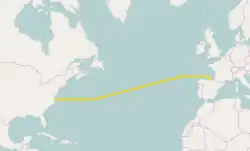
MAREA is a 6,605 km (4,104 miles)[1] long transatlantic communications cable connecting the United States with Spain. Owned and funded by Microsoft and Meta Platforms, but constructed and operated by Telxius, a subsidiary of the Spanish telecom company Telefónica,[2] it is the "highest-capacity submarine cable in the world" with a system design capacity of 200 terabits per second as of 2019.[3]
History
In May 2016, Microsoft, Facebook (Now Meta Platforms), and Telxius announced the MAREA project, saying that it would provide the Eastern United States, most of whose internet traffic flows through New York, with "a more efficient path not only to Europe but to Africa, the Middle East, and even Asia".[4] According to Microsoft's Director of Global Network Strategy for Cloud Infrastructure and Operations, one impetus for the project was sparked by the service disruptions caused by Hurricane Sandy in October 2012.[5][6]
Construction began shortly afterwards, in August 2016, and was completed in September 2017, connecting Virginia Beach, Virginia, in the United States, with Sopelana, a town near Bilbao, Spain. It began operations in February 2018.[7]
In January 2019, Telxius announced that AWS had signed an IRU agreement to use one of MAREA's eight fiber pairs (Microsoft and Facebook each own two pairs, and Telxius will have three pairs for other customers and its own use.[3][8]
Operation
Telxius was responsible for the construction and operation of the cable, which connects Virginia Beach, Virginia, in the United States, with Sopelana, Spain (near Bilbao).
The cable was initially expected to have a transmission speed of 160 terabits per second. (Specifically, 8 fiber pairs * 25 DWDM channels * 400 Gbit/s per single carrier (16-QAM modulation) = 160 Tbit/s). But in 2019, a research team reported they had generated signaling speeds of 26.2 Tbit/s (per fiber pair) on MAREA cable, 20 percent higher than believed feasible when the cable was designed.[9] [10]
The cable weighs approximately 4.65 million kilograms,[6] and is composed of eight pairs of fiber-optic cable bundles.[11]
See also
References
- ↑ "Submarine Cable Map". www.submarinecablemap.com. Retrieved 2023-01-23.
- ↑ "MAREA and BRUSA". Telxius. Retrieved 14 January 2020.
- 1 2 Qiu, Winston (21 January 2019). "AWS Acquires a Fiber Pair on MAREA Cable System on IRU Basis". Submarine Cable Networks. Retrieved 14 January 2020.
- 1 2 Cade Metz (26 May 2016). "Facebook and Microsoft Are Laying a Giant Cable Across the Atlantic". Wired. Retrieved 14 January 2020.
- ↑ Bach, Deborah (21 September 2017). "Microsoft, Facebook and Telxius complete the highest-capacity subsea cable to cross the Atlantic". Microsoft News. Retrieved 14 January 2020.
- 1 2 Grossman, David (September 22, 2017). "Microsoft, Facebook, Complete Enormous Undersea Cable".
- ↑ Kidd, Beverly (27 February 2018). "Va. Beach to become tech hub teaming up with giants like Microsoft, Facebook". WKTR. Retrieved 14 January 2020.
- ↑ "Telxius and Amazon Web Services reach agreement on transatlantic subsea cable MAREA". Telxius. 19 January 2019. Retrieved 14 January 2020.
- ↑ Grubb, Stephen; Mertz, Pierre; Kumpera, Ales; Dardis, Lee; Rahn, Jeffrey; O’Connor, James; Mitchell, Matthew (2019). "Real-time 16QAM Transatlantic Record Spectral Efficiency of 6.21 b/s/Hz Enabling 26.2 Tbit/s Capacity". OSA Technical Digest. Optical Fiber Communication Conference (OFC) 2019: Optical Society of America. paper M2E.6.
{{cite conference}}: CS1 maint: location (link) - ↑ Mertz, Paul (25 February 2019). "Researchers Break Efficiency Record for Data Transfer in Ultra-fast Transatlantic Cable". www.ofcconference.org. Optical Society of America. Retrieved 15 March 2019.
- ↑ "Tech giants are building their own undersea fibre-optic networks". The Economist. 5 October 2017.